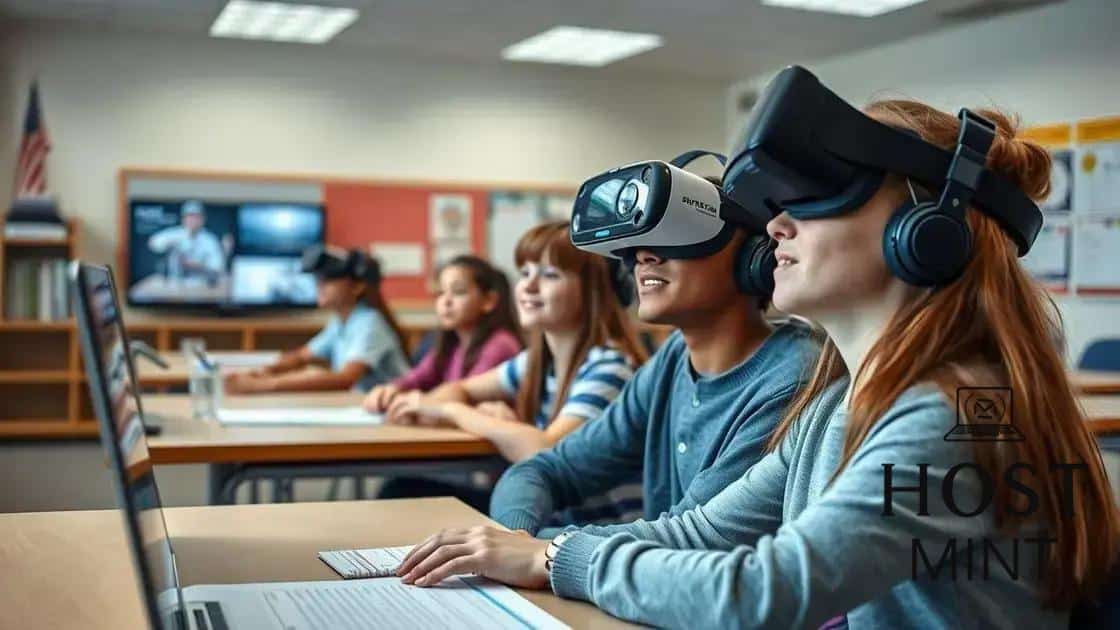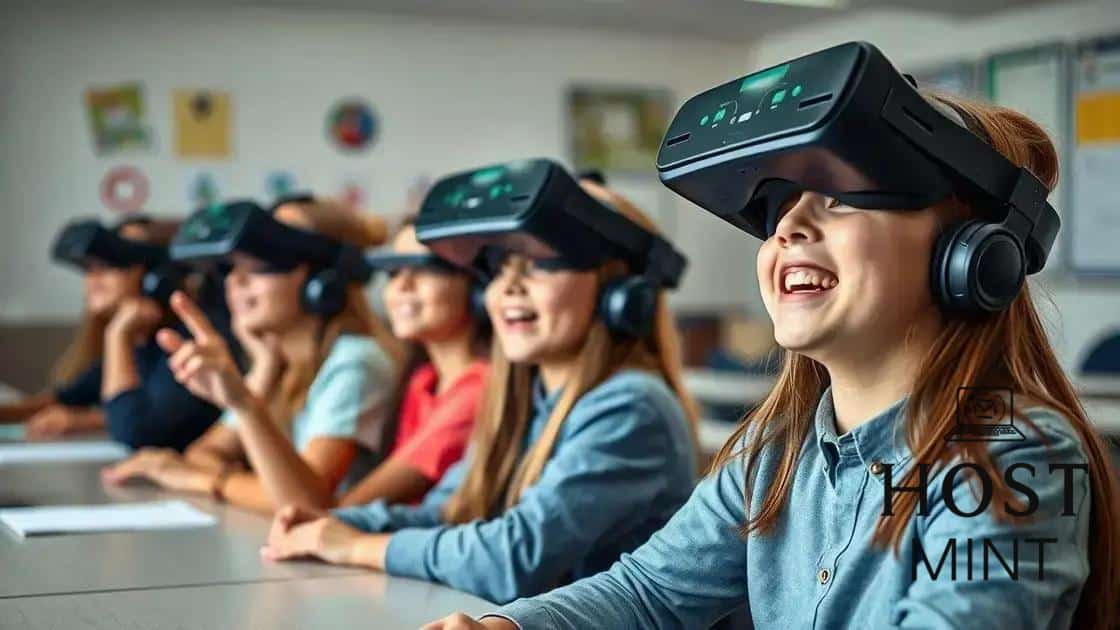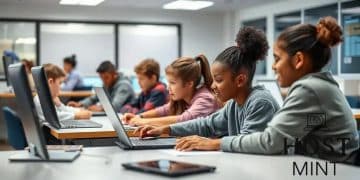How schools are using VR for student engagement

Schools are using VR for student engagement by providing immersive learning experiences, enhancing understanding of subjects, and personalizing education, thereby making learning more interactive and accessible.
How schools are using VR for student engagement is reshaping the way students interact with their learning environments. Imagine stepping into a history lesson where you can walk through ancient Rome! This technology opens doors to experiences that textbooks simply can’t provide.
Understanding the impact of VR on learning
Understanding the impact of VR on learning is crucial as schools begin to embrace this technology. Virtual reality offers an immersive experience that captures students’ attention in a way traditional methods cannot.
When students wear VR headsets, they can explore different environments and scenarios. This hands-on approach not only makes learning enjoyable but also helps in retaining information more effectively.
How VR Enhances Learning
One of the biggest advantages of VR is its ability to present complex concepts through visualization. For example, students studying science can virtually conduct experiments without leaving the classroom. This not only boosts engagement but also fosters critical thinking skills.
- Interactive simulations provide real-world applications.
- Students can learn at their own pace and revisit challenging concepts.
- VR makes abstract ideas more concrete.
- Enhanced collaboration among students can occur through group VR activities.
Moreover, VR eliminates geographical barriers. A student in one part of the world can take a virtual field trip to another country, experiencing diverse cultures and environments directly from their classroom. This global exposure enriches their educational experience.
Another significant impact is in the realm of special education. Students with learning disabilities can greatly benefit from customized VR experiences that cater to their unique needs. This personalized approach helps level the playing field and promotes inclusivity.
Challenges of Implementing VR
While the advantages are clear, schools face challenges when adopting VR. The technology can be expensive, and educators require proper training to integrate it effectively into their curriculum. Additionally, some may argue that spending too much time in virtual environments can detract from traditional learning experiences.
Ultimately, understanding the impact of VR on learning involves recognizing both its potential and the hurdles that need to be addressed. As educators and institutions work towards overcoming these barriers, the future of learning may well rest on the successful integration of VR.
Benefits of virtual reality in education

The benefits of virtual reality in education are transforming how teachers deliver lessons and how students engage with their studies. By immersing students in VR environments, learning becomes interactive and captivating.
One major advantage is the ability to create realistic simulations. For instance, students can conduct science experiments or explore historical events without leaving their classroom. This hands-on approach encourages deeper understanding and retention of knowledge, making learning more effective.
Enhanced Engagement
When students use VR, their attention and interest increase significantly. Unlike traditional lectures, VR allows learners to step into a scenario. They can experience being in the past or explore the deep sea, igniting curiosity and passion for subjects.
- Immersive experiences lead to greater focus.
- Students can visualize complex subjects easily.
- Interactive learning encourages collaboration.
- Learning becomes fun and memorable.
Additionally, VR supports diverse learning styles. Visual learners can benefit from seeing concepts come to life, while kinesthetic learners can interact with their surroundings. This flexibility accommodates all students, improving overall learning outcomes.
Moreover, VR can help bridge gaps in education. Students in remote areas or low-resource schools can access high-quality learning experiences that were once unimaginable. They can virtually visit the best museums, landmarks, or natural wonders, enhancing their knowledge and worldviews.
Support for Special Needs
Another significant benefit is its application in special education. VR can create tailored environments for students with autism or disabilities, allowing them to practice social skills and emotional regulation in safe spaces. This personalized approach fosters confidence and improves social interactions.
In summary, the benefits of virtual reality in education are profound. By enhancing engagement, supporting diverse learning styles, and providing equitable access to quality education, VR has the potential to revolutionize the learning landscape.
Real-world examples of VR implementation
Real-world examples of VR implementation in education highlight how this technology enhances learning experiences across various subjects and grade levels. Schools around the world are beginning to recognize the potential of virtual reality to create immersive learning environments.
One notable example is Google Expeditions, a tool that allows teachers to take students on virtual field trips. Students can explore the Great Barrier Reef or visit the Louvre, all from their classroom. This tool sparks curiosity and provides a deeper understanding of global cultures and geography.
Medical Training
In the medical field, VR is revolutionizing how students learn. Programs like SmartVR teach anatomy through interactive experiences. Medical students can practice surgeries in a safe virtual environment. This method not only enhances their skills but also builds confidence before they engage with real patients.
- Allows for risk-free practice of complex procedures.
- Enables instant feedback and evaluation.
- Students can learn at their own pace.
- Improves muscle memory and skill retention.
Further, in the realm of architecture, students use VR to visualize their designs. Platforms like Enscape help architecture students walk through their creations. By simulating space, students gain insights into how lighting and materials affect their designs, leading to better outcomes in real-world projects.
Language Learning
For language learners, VR creates immersive environments where students can practice speaking in realistic scenarios. Programs like ImmerseMe allow learners to engage in conversations in simulated restaurants or marketplaces. This live practice helps build confidence and fluency.
Additionally, schools in remote areas benefit from VR to access quality education. Students in under-resourced regions can explore advanced science labs or art studios virtually, ensuring they receive the same opportunities as those in more privileged areas. This equal access is crucial for fostering educational equity.
In summary, real-world examples of VR implementation showcase how diverse and beneficial this technology can be in education. From immersive field trips to medical training and language learning, VR is changing the educational landscape, making learning more engaging and effective.
Challenges faced by schools adopting VR
Challenges faced by schools adopting VR technology are significant, yet understanding them is crucial for successful integration. While virtual reality offers exciting educational possibilities, hurdles remain that educators must navigate.
One major challenge is the cost of VR equipment and software. Schools often operate on tight budgets, making it difficult to allocate funds for headsets, computers, and necessary licenses. This financial barrier can restrict access to VR tools, especially in underfunded schools.
Training and Knowledge Gaps
Another obstacle is the need for proper training. Teachers must feel comfortable using VR technology to implement it effectively in their lessons. Without adequate professional development, instructors may struggle with the technology, limiting its potential benefits. Additionally, not all educators are familiar with the latest advancements in VR, resulting in a knowledge gap that can hinder successful adoption.
- Some teachers lack experience with technology.
- Training sessions can be time-consuming.
- Keeping up with rapid tech changes is difficult.
- Many educators may feel overwhelmed by the new tools.
Moreover, there are concerns regarding the content available. Not all VR educational programs are high quality or align with curriculum standards. Schools need to evaluate and choose content that promotes learning and supports learning outcomes effectively. If the content is not engaging or relevant, the VR experience may not have the desired impact on students.
Technical Integration Issues
Technical challenges can also arise during the integration of VR into existing systems. Schools must ensure that the technology is compatible with their infrastructure. Issues with internet connectivity or software compatibility can halt the use of VR applications. Additionally, stable and robust technical support is essential to address any issues promptly.
Furthermore, safety and distraction concerns play a role in hesitance to adopt VR. Educators must consider how to manage students’ use of VR headsets in a way that keeps them safe and focused on learning. Striking a balance between immersive experiences and maintaining a productive classroom environment can be challenging.
Overall, despite the numerous benefits that VR offers, schools must address these challenges carefully. Tackling budget constraints, providing adequate training, ensuring content quality, and overcoming technical hurdles are crucial steps for successful implementation of VR in education.
Future trends in educational technology
Future trends in educational technology are shaping how students learn and interact with content in the classroom. As we see advancements in tools such as virtual reality and artificial intelligence, education is becoming more personalized and engaging.
One exciting trend is the increased use of VR in immersive learning environments. Schools will continue to adopt VR to enhance subjects like history and science. This technology allows students to experience different eras or scientific phenomena firsthand, making learning more impactful and memorable.
Artificial Intelligence and Personalization
Another significant trend is the incorporation of artificial intelligence. AI can analyze students’ learning behaviors and adapt content accordingly. This means lessons can be tailored to fit each student’s unique pace and understanding. With AI, teachers can focus on individual needs and provide targeted support.
- Adaptive learning platforms will help students progress through material suited to their needs.
- AI chatbots will assist students with questions, providing immediate feedback outside class hours.
- Data analytics will help educators enhance their teaching strategies.
- Personalized learning paths will become more common, allowing students to explore their interests.
Furthermore, the rise of online learning is a pivotal trend. Hybrid and fully online courses are becoming common, allowing students to learn from anywhere. This flexibility not only accommodates different learning styles but also helps reach students who may not thrive in traditional classroom settings. The shift towards online learning creates opportunities for global classrooms where students can collaborate across borders.
Gamification in Learning
Additionally, gamification is on the rise. Teachers are using game-based learning to motivate students. Incorporating elements like competition, rewards, and challenges into lessons makes learning exciting. This approach encourages students to be more engaged and can improve retention of information.
Finally, schools are beginning to embrace mobile learning more than ever. With the widespread use of smartphones and tablets, educational apps and resources are available at students’ fingertips. This mobile accessibility allows learning to happen anytime and anywhere, enhancing student engagement and efficiency.
In summary, the future trends in educational technology promise a transformative experience for students and teachers alike. By leveraging VR, AI, online platforms, gamification, and mobile learning, education is set to evolve dramatically, fostering a more inclusive and effective learning environment.
The adoption of virtual reality in education presents exciting opportunities for both students and teachers. By enhancing learning through immersive experiences, personalized content, and innovative technology, **VR** is changing the classroom landscape. However, it’s essential to address the challenges that arise from cost, training, and content quality. Overall, as schools navigate these obstacles, the potential for **VR** to create engaging and effective learning environments is limitless. Embracing these advancements will lead to a brighter future for education, making it accessible, enjoyable, and enriching for all students.
FAQ – Questions about Virtual Reality in Education
How does virtual reality enhance learning?
Virtual reality allows students to immerse themselves in experiences, making learning engaging and more memorable.
What are the costs associated with adopting VR technology?
The costs include purchasing VR headsets, computers, and software, which can be significant for schools on tight budgets.
What training is needed for teachers to implement VR?
Teachers require professional development to feel comfortable using VR technology effectively in their classrooms.
How can VR support students with special needs?
VR can create tailored environments for students to practice social skills and navigate challenges in a safe, controlled setting.






